‘If home is found on both sides of the globe, home is of course here – and always a missed land,’ wrote the Kashmiri-American poet Agha Shahid Ali. Last month the Ishara Art Foundation opened its doors on Dubai’s Alserkal Avenue with a show exploring the ideas of home, its absence, and the distances in between.
‘Altered Inheritances: Home is a Foreign Place’ takes its title from a work by each of its two artists, Shilpa Gupta and Zarina. In the photo installation Altered Inheritances – 100 (Last Name) Stories (2014), Gupta presents stories of individuals who have changed their names in order to succeed or survive. These range from a freed slave who takes his master’s name in ancient Rome to Holocaust survivors seeking to avoid further persecution or prejudice, to actor Caryn Elaine Johnson, who took the name Whoopi Goldberg to progress in what was perceived to be a Jewish-dominated stage industry. Zarina (who, professionally, sheds her own last name, Hashmi) made Home is a Foreign Place, a set of 36 woodcuts on Kozo paper, back in 1999. These monochromatic, geometric images relate to the Urdu words accompanying them. The first print in the series, Ghar (Home), reproduces the floorplan of Zarina’s childhood home in Aligarh, Uttar Pradesh.
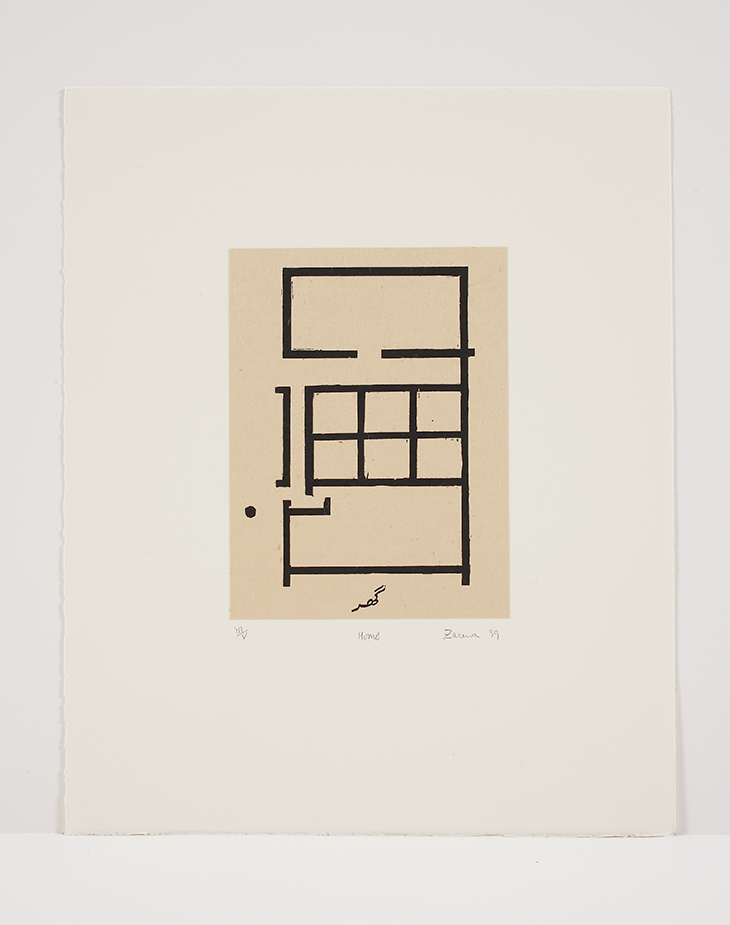
Home from Home is a Foreign Place (1999), Zarina. Prabhakar Collection, Dubai. Courtesy the artist and Luhring Augustine, New York; © Zarina
This is a motif that recurs throughout the show, which is itself laid out to recall that childhood floorplan. In a video projected on to the floor of one room, the artist Sophie Ernst asks Zarina to reconstruct the layout of the house in Aligarh – which she and her family were forced to leave in the violent aftermath of Partition – using old photos. A series of woodcuts from 1997, Homes I Made/A Life in Nine Lives, traces the floorplans of the artist’s homes since 1958: Bangkok (First Home), New Delhi (Planted a garden of roses from Aligarh), Paris (Watched the Seine flow by and waited for him to come home), New Delhi again (A room of my own), Bonn (An uncertain time), Tokyo (A room of four and a half tatami), Los Angeles (Edge of temporariness), Santa Cruz (A horizontal blue line), New York (A space to hide forever).
Many of Gupta’s works are concerned with the cartographical – floorplans writ large, if you like. 100 Hand drawn maps of my country, India (2008–14) collates, in carbon tracings on paper, the outlines made by people asked to draw a map of India from memory. Elsewhere, a length of delicate copper wire has been twisted and shaped into a territory outline, hung not flat against the wall but proud of it, so that those twists and turns cast shadows on the wall, forming another set of boundaries altogether. Which map is true? The final work of the exhibition, Gupta’s Speaking Wall, continues this concern with the arbitrary and shifting nature of borders. The installation from 2009–10 includes a sensor on the wall, and a headset for the viewer to wear while a voice issues instructions on where to step – ‘A bit closer, closer… Now you are no longer stepping on the border. Are you not able to see it? It is on the ground below you. The wind shifted it by a few centimetres.’
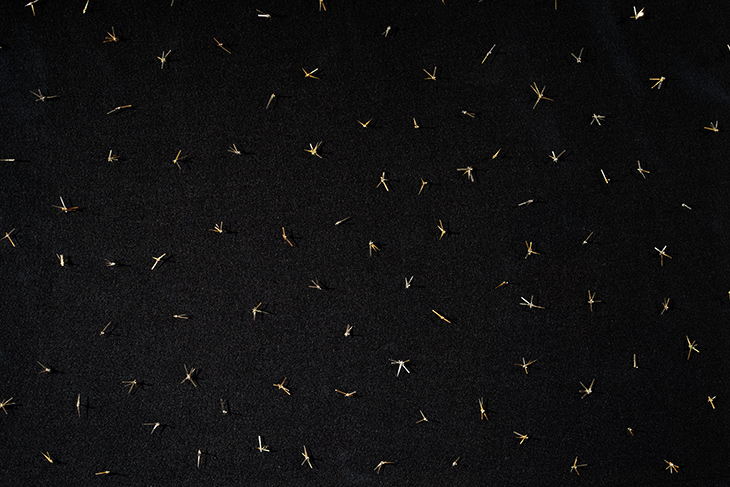
Wrist Watch Hands (2014), Shilpa Gupta. Prabhakar collection, Dubai
If these two Indian artists, a generation apart, have common thematic threads, they also complement each other visually. That delicacy of metallic line in Gupta’s copper-wire work is echoed in Zarina’s etching Golden Route (1982); an exquisite-looking installation by Gupta of what appear to be tiny golden birds or insects – in fact wristwatch hands pinned to black felt cloth – seems to be answered by Zarina’s Crawling House (1994), a wall of 500 hand-cut tin pieces based on a simplified house shape. Zarina’s woodcut print Beyond the Stars (2014), peppered with gold leaf, is a poetic evocation of the cosmic. Constellations also appear against a blue ground in a carbon drawing by Gupta of the same year; here the ‘stars’ are punctures in the paper, and represent floodlights along India’s border with Bangladesh.

Beyond the Stars (2014), Zarina. Courtesy Zarina
Seventy per cent of the works in this show come from the personal collection of the Ishara Art Foundation’s founder, Smita Prabhakar. Like Zarina, Prabhakar was born in Uttar Pradesh, but has lived for nearly 40 years in Dubai. The foundation, with Nada Raza (a former curator at Tate Modern) at its helm as artistic director, focuses on contemporary South Asian art. ‘For me, Dubai is a part of expanded South Asia,’ Raza has said in interview. ‘The art histories of this region and those of India and Pakistan and Bangladesh, are completely imbricated with one another, and there are many conversations that still need to be had.’ (The opening of this show only a month after renewed hostilities between India and Pakistan make it all the more relevant.)
Dubai certainly offers itself as a natural hub for art from the MENASA region. In Alserkal Avenue’s impressive main venue, Concrete, Shilpa Gupta also had work in the recent group show ‘Fabric(ated) Fractures’, part of a series exploring border enclaves between India and Bangladesh, commissioned by the Samdani Art Foundation in Dhaka. Similar themes of displacement and recalling lost homes could be found elsewhere on the avenue at the time of the Ishara Art Foundation’s inauguration. In Iman Hasbani’s photomontage Separation (2017), part of a show of Syrian women artists at the Atassi Foundation, the artist, who lives in Berlin, dreams herself back to the garden of her childhood in the south of Syria in 1989. Meanwhile, the Amersfoort-based Iraqi artist Sadik Kwaish Alfraji’s achingly beautiful animation in his exhibition ‘The River that was in the South’ at Ayyam Gallery reimagines the migration journey of his grandfather’s generation, displaced from southern Iraq during the 1980s and ’90s when Saddam Hussein drained the area’s marshlands. ‘The dream of migration always seems rosy… / And the paths of migration glisten like gold painting a bright horizon,’ writes Alfraji. ‘These works are an attempt to touch the visions of those early migrants, and those of us, we, who are still on the move… driven by our everlasting yearnings to visualise a heaven we shall forever stand on its edges.’
‘Altered Inheritances: Home is a Foreign Place’ is at the Ishara Art Foundation, Alserkal Avenue, Dubai until 23 June. ‘Sadik Kwaish Alfraji: The River that was in the South’ is at Ayyam Gallery, Alserkal Avenue until 25 April.
Unlimited access from just $16 every 3 months
Subscribe to get unlimited and exclusive access to the top art stories, interviews and exhibition reviews.


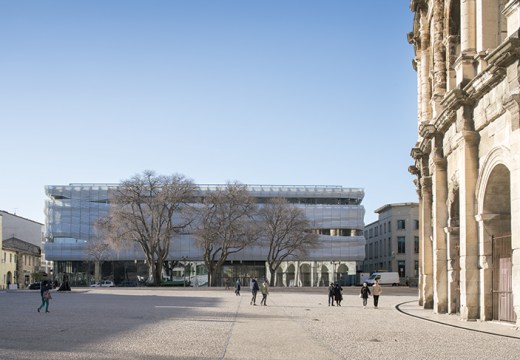
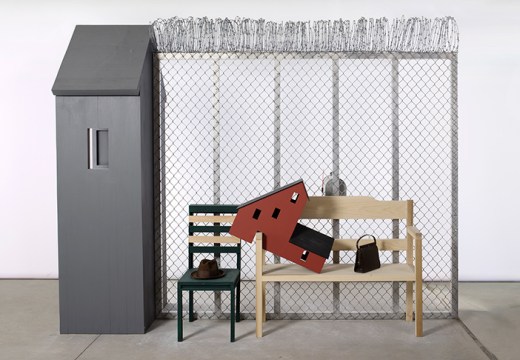
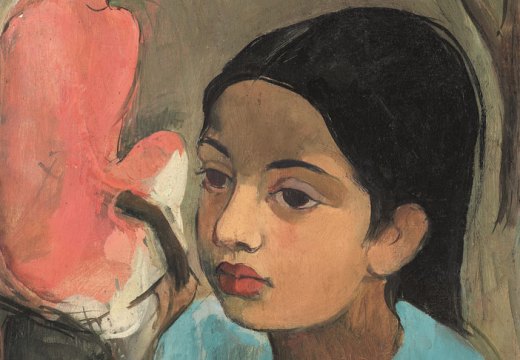









![Masterpiece [Re]discovery 2022. Photo: Ben Fisher Photography, courtesy of Masterpiece London](http://www.apollo-magazine.com/wp-content/uploads/2022/07/MPL2022_4263.jpg)
It’s time for the government of London to return to its rightful home